Welcome, guitar compressor lovers!
I want to show you five of the best compressor pedals available in the market to shape and enhance your guitar tone.
In this article, you will find everything you have to learn before picking your next compressor. I’ll also give you some interesting customization tricks to get the best sound out of them.
So, let’s go directly to my selection of the Best Compressor Pedals.
Quick Overview
Our Top 3 Choices For Best Compressor Pedals
Wampler Ego Compressor Pedal
The Wampler Ego Compressor delivers high-quality compression and versatility like you have never experienced using other compression pedals.
Origin Effects Cali76 Compact Deluxe
Origin Effects put the sound and feel of a Urei 1176 Studio’s compressor into a guitar pedal with the Cali76 Compact Deluxe. It provides epic compression and sustain with low noise and studio-like transparency.
Boss CP-1X Compressor
The BOSS CP-1X Compressor is among the best compressor pedals available today. It has the high quality of its predecessors like the Boss CS 3, CS 2 & CS 1. It may be considered a pioneer of a new generation in guitar compressor pedals.
The 5 Best Compressor Pedals to Improve Your Guitar Rig!
#1. Wampler Ego Compressor Pedal
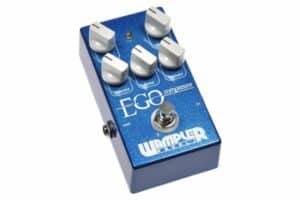
When looking for the best guitar compressor pedal that exceeds your expectations, take a look at the Wampler Ego Compressor. It delivers high-quality compression and versatility like you have never experienced using other compression pedals.
If you need to keep your tone and compressed signal as if there were no pedals in line, then the Wampler Ego will do a good job in this field thanks to its True Bypass capabilities.
The Ego seems to be the best compressor pedal available in the market right now. You can use it just as a clean boost or as an EQ & Boost compression combination.
The Wampler has a complete layout with its five knobs to control all the spectrum of the compressing effect:
- The Sustain knob lets you control the level of compression effect. Sustain let you go from a complete no compression transparency clean sound to a really sustained musical feeling.
- The Attack knob allows you to increase how quickly the compression starts working on the signal Clockwise. It is essential to learn how to use it because you need to dial it until the sound fits your overall tone needs.
- The Tone control is very unusual in compressor pedals, and it will let you handle the tone’s voice. It will be out of the signal when you turn it counter-clockwise as if it were an old-style compressor without tone control.
- The Blend control will let you manage the real masterwork of the Ego Compressor Pedal. This knob gives you the ability to blend the original signal with the compression effect at a proper 50/50 level. If you turn it completely to the dry side, it will improve the tone of your initial signal without bringing in the compression circuit.
- The Volume knob will help you experience the amazing Wampler pedals output volume level potential.
The Ego Compressor deserves that you spend some time adapting this pedal to your sound. Be patient while getting the right feel with this pedal. Usually, less is more in using a compression pedal. Don’t forget to use the new manuals to access some great setting tips.
You’ll love this:
- Possibly the best compressor pedal available today.
- One of the most versatile compressor pedals on the market.
- It includes True Bypass.
- It brings top-notch resistors/capacitors that deliver outstanding sound quality and responsiveness.
- The Blend control feels really amazing when you mix your unaffected signal with the compression signal of the pedal.
- It has a great build quality and a very transparent pedal design.
- It supports a 9V-18V DC power supply (sold separately).
You might not like this:
- It may take you some time to learn how to handle all these controls.
PROS
- Great variety of controls.
- Solid build.
- Versatile tones via blend knob.
- Good range of compression.
CONS
- You might prefer the mini version.
#2. Origin Effects Cali76 Compact Deluxe
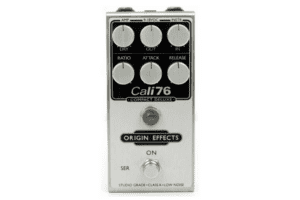
Origin Effects put the sound and feel of a Urei 1176 Studio’s compressor into a guitar pedal with the Cali76 Compact Deluxe. It provides epic compression and sustain with low noise and studio-like transparency.
Origin Effects managed to build all of the functionality from their flagship Cali76 Standard into this little wonder pedal. But they have added a parallel mix control previously found only on some of their limited editions.
This pedal separate controls for Attack, Release, and Compression Ratio will allow you to manage your tone with high precision. While the Cali76 elegant jewel lamp functions as an intuitive three-color gain reduction meter.
Let see what you can do with Cali76’s complete set of controls:
- IN: The In control allows the user to vary the gain of this preamplifier. This works as an interface between the guitar and the compressor sections by amplifying the dry guitar signal before applying additional processing. Turning the In control clockwise increases the overall gain of the pedal while increases the amount of compression.
- OUT: The Out control defines the level of the signal present at the pedal’s output. This can be set to keep the overall wet signal level close to that of the dry signal. You can use the OUT level by increasing it to help highlight a guitar solo.
- DRY: The Dry control varies the amount of uncompressed signal present at the pedal’s output. By adjusting the Out and Dry knobs, you can adjust the balance between the compressed and uncompressed signals.
- RATIO: The Ratio control allows you to adjust the amount of gain attenuation applied for any given increase in guitar signal. Lower ratio settings will provide more gentle, transparent compression, while higher ratio settings will deliver more aggressive compression.
- ATTACK: The attack parameter can be thought of as the time from the instant when you play the note to the moment the compressor actually reduces the gain. So turn the Attack control anti-clockwise to increase the attack time. Significantly reducing the attack time will result in undesirable distortion being generated. Increasing the attack time highlights the percussive “snap” of picked notes.
- RELEASE: The release parameter of the pedal is used to set the gain attenuation duration applied to the signal. Turn the Release knob anti-clockwise to increase the release time. For maximum effect, the release time must be set so that the compressor responds fully to every note played.
The JEWEL METERING functions this way:
- Red for no compression.
- Orange for active compression.
- Yellow signifies that gain attenuation has reached 27dB.
- The brighter the lamp, the more significant the gain attenuation.
- Maximum compression occurs around 38dB.
You’ll love this:
- The Cali76 Compact Deluxe pedal is for those seeking maximum in-depth control thanks to its ratio, attack, and release knobs.
- This is an 1176-style studio-grade FET compressor.
- This pedal features a low-noise, discrete Class-A circuitry.
- Include a dedicated parallel compression control.
- It has a great build quality, all contained in one of the most compact guitar pedals.
- It supports a 9V-18V DC power supply (sold separately).
You might not like this:
- Lack of the Cali76 original’s 12-LED gain reduction meter.
PROS
- True parallel compression.
- Transparent compression and sustain.
- Produce three-dimensional, bright tones.
CONS
- It can be a little tricky for beginners.
#3. Boss CP-1X Compressor
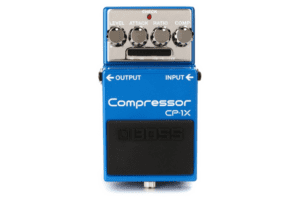
The BOSS CP-1X Compressor is among the best compressor pedals available today. It has the high quality of its predecessors like the Boss CS 3, CS 2 & CS 1. But rather than simply following the path, it may be considered a pioneer of a new generation in guitar compressor pedals.
Boss equipped the CP-1X pedal with Multi-Dimensional Processing technology. This technology allows you to shape your tone to the most satisfactory degree of detail while processing and maintaining the expressive distinctions of your playing.
The BOSS’s MDP technology analyzes the guitar signal in multiple dimensions providing advanced dynamics control. It avoids the pedal to color the original tone as typical compressor pedals do.
The CP-1X presents a simple to use interface with a four-knob (Level-Attack-Ratio-Comp) and a handy gain attenuation indicator that shows how much compression is being applied:
- The Level knob controls the output volume of the effect. This allows you to manage those settings that have a greater volume drop, or you can use the compressor as a tool to boost your solo.
- The Attack knob controls how quickly the compressor starts processing each note. Turning fully clockwise will allow the compressor to manipulate your notes very subtly. In contrast, anti-clockwise reduces the amount of note-attack.
- The Ratio knob controls how much compression is applied to your signal as the signal’s level increases. It also determines the speed of the transitions from min to max compression.
- The Comp knob determines when the effect begins to be applied. It allows you to choose the point in the upper dynamics when the compression begins to take effect.
- This pedal brings a Gain Attenuation Meter. It is a handy LED bar-graph indicator that indicates in decibels the amount of signal reduction that is occurring at every time.
The CP-1X pedal is optimized for all types of guitars. It offers high-quality performance for every music style. The CP-1X is a multi-band compressor, meaning that it compresses different frequency ranges in complementary ways.
You’ll love this:
- The CP-1X is a wonderful upgrade to the BOSS product line of compact compressor pedals.
- The CP-1X has a user-friendly set of controls (Level-Attack-Ratio-Comp) and a studio-style response.
- This multi-band compressor unit is perfect sounding. It allows natural frequency response at high signal levels.
- The 9V battery compartment is easy to access, and it supports a 9V DC power supply (sold separately).
You might not like this:
- It would be better to change the mirror backing and mirror-finished knobs. Something with higher contrast against the text and the knobs markers would have been a better choice.
PROS
- Excellent performance.
- Great gain-reduction indicator.
- Easy-to-use layout.
CONS
- It can be an expensive option.
- 9V battery life can be short.
#4. Keeley Compressor Plus
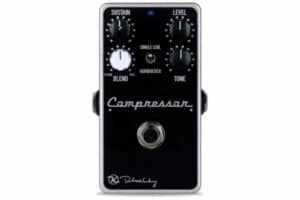
The Keeley Compressor Plus pedal is based on the 1970s Ross Compressor, a near-clone of the earlier MXR Dyna-Comp. Both of them had just two knobs for compression amount and volume.
The Compressor Plus remains a simple ’70s-style compressor stompbox, but it has some very nice new options. It replicates the tones of earlier Keeley models while adding several meaningful new features:
- A blend control.
- A post-compression tone circuit.
- A single-coil/humbucker toggle.
The Keeley Compressor Plus offers the same gorgeous push of frequencies and sweetening of tone of the old compressors, now with the flexibility to handle any instrument quickly.
The controls of the Keeley Compressor Plus include:
- Blend: This knob is a way of getting the peaks to come through while having sustain at the same time. So if you want more sustain than peak-limiting, adjust it and add sustain on the back end.
- Level: Here, you adjust your output level. Turn it up to boost your sound.
- Sustain: Thanks to its expander/sustainer, the Keeley Compressor Plus adds more gain as notes fade out. It also adds just the right amount of sustain and expressive bloom to your notes.
- Tone: this control emphasizes the most sensitive harmonics that can be lost in compression. This control retains the peaks in your playing and, more importantly, the proper phasing of your guitar signal.
- Release Switch: It is designed for an easy transition between single-coil and humbucker guitars. Humbuckers have more average energy than a single-coil, which can cause compressors to stay in “compression mode” for a lot longer. Using the Release Switch, your humbuckers remain properly sounding, and each note retains dynamic attack and definition.
You’ll love this:
- The Compressor Plus was made to create the best amp boost you’ve heard.
- The best option for players wanting a smooth compression effect for their guitar.
- Remove just the right amount of peaks for an ambient layer.
- Blend in the right amount of treble for a lovely shimmer to your guitar.
- It supports a 9V DC power supply (sold separately), and there’s a 9V battery compartment.
You might not like this:
- Note and chord attacks may lose impact when it isn’t accurately configured.
PROS
- Fine Ross/Dyna-Comp-style.
- Added controls permit subtle settings.
- Great price.
CONS
- Don’t have a great level of accuracy configuration.
#5. MXR M102 Dyna Comp Compressor Pedal
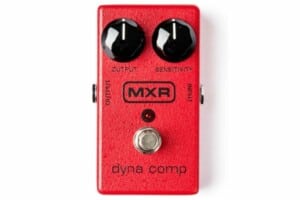
The MXR Dyna Comp was released in 1972 and soon became a success due to its ease of use and competitive price. This classic model smoothes out the volume difference between notes and produces a dynamic range compression.
Richard Neatrou and Keith Barr designed the original model. They wanted to create a voltage-controlled amplifier (VCA) that worked adequately on guitars. After a period of experimentation, the original Dyna Comp was born.
The finished unit still didn’t have a particularly great signal-to-noise ratio when Dunlop bought out MXR in 1984.
But it was more than enough in the context of the time. Being one of the first and well-known compressors, it was widely cloned.
The MXR Dyna Comp pedal added a great deal of color to the signal. The ‘fattening’ effect made it very popular among country players who usually use Telecasters with single-coil pickups.
There are three main differences between the actual and the original MXR Dyna Comp:
- An indicator LED.
- True-bypass switching.
- The IC initially used a CA3080 IC; it switched to a DIP-style chip later.
- It supports the Dunlop 9V Power Supply.
The magic of the MXR Dyna Comp has come from players such as Adrian Belew, Sonny Landreth, or David Gilmour. It appeared on countless boards and records over the years.
The MXR Dyna Comp’s control layout is the most simple of all the compressors’ pedals in this article. It has only two knobs, Output and Sensitivity:
- Output: The output control on the Dyna Comp simply attenuates the signal just before the output jack. The core of the circuit makes the pedal have variable gain, so the output allows the player to moderate this amplified signal. More ‘open’ sounds will tend to be high output because the output control does not vary the gain actively.
- Sensitivity: A typical studio compressor will have controls over the threshold, ratio, attack, and effect release. But on the Dyna Comp, the compression is completely controlled via the Sensitivity knob because the unit’s attack is present.
The Dyna Comp’s customization is about setting an attenuation level and a boost level. The goal is to smooth out the signal so that the overall average level can be brought up, and a heavily-compressed signal will have a less dynamic range.
You’ll love this:
- The most easy-to-use pedal on the market.
- It provides control over the ratio and delivers a warm compressed tone.
- Maybe the perfect choice for compressors’ new players on a budget.
- It supports a Dunlop 9V Power Supply (sold separately).
You might not like this:
- Experienced players need to consider a higher-budget option.
PROS
- Excellent Sound Quality
- Versatile
- Compact
- Affordable
CONS
- Limited Selection Of Effects
- Poor Sound Quality
Best Compressor Pedals Most Asked Questions
What is a compressor pedal good for?
A compressor pedal can be one of the most valuable tools you can have in your setup. It’s a versatile effect that can alter an instrument’s tone. A compressor pedal is a useful device for taming dynamics.
Many guitar players use an EQ pedal to fix problems that a compressor pedal is better suited for. A compressor will do a better job than most EQ pedals when a guitar player is trying to stop the low frequencies from overtaking the highs.
An audio compressor is a specialized amplifier that reduces the gap between the loudest part or peak and the quietest part of a signal. A compressor pedal can also make a solid-state amp sound more like a tube amp.
The difference in volume bet A compressor pedal can be one of the most valuable tools you can have in your setup. It’s a versatile effect that can alter an instrument’s tone. A compressor pedal is a useful device for taming dynamics.
Many guitar players use an EQ pedal to fix problems that a compressor pedal is better suited for. A compressor will do a better job than most EQ pedals when a guitar player is trying to stop the low frequencies from overtaking the highs.
An audio compressor is a specialized amplifier that reduces the gap between the loudest part or peak and the ween the peak and average levels of an audio signal is called the dynamic range. A compressor is a device created to reduce this range.
A compressor has the capacity to reduce the difference for the peak notes to be quieter and the quiet notes to be louder and produce a more even-sounding signal.
Do I need a compression pedal?
Compressor pedals are commonly used to enhance the sound of a clean guitar. Compression extends the life of the notes played on a guitar by raising the volume. Usually, notes played with a clean guitar tone lack sustain and begin to decay quickly after the string is plucked.
Compression also works very well with the fingerstyle or hybrid picking used by country guitarists. A compressor allows achieving a balanced sound playing fingerstyle electric guitar by leveling out the different strings’ dynamics.
It is the case of country guitarists that usually use a compressor pedal to achieve a distinctive sound. A compressor lets you get more sustain for rock or blues leads. Blues guitar players use a compressor with a light overdrive pedal to fatten their tone even further.
This effect is notably beneficial for these particular cases:
- Helping a quiet, finger-picked part be heard in a mix.
- Making sure two-handed tapping, legato-style hammer-ons, and pull-offs.
- That artificial or harp harmonics don’t disappear in between hard strumming.
- It is ideal for getting that classic “squishy” funk guitar tone when playing staccato chords.
What does a compressor do to a guitar?
Beginner or intermediate guitarists often overlook distortion, delay, or a phase shifter. Compression is a more subtle effect but, when used properly, can shape and enhance your guitar tone in some rather significant ways.
In a recording studio, compression is used to control the audio signal’s dynamics and overall level. A compressor pedal can make you reach more sustain, a strong tone, and a more balanced sound.
This effect fattens up the tone and provides more sustain in addition to balancing the complete sound. Compressor pedals are commonly used to enhance the sound of a clean guitar.
Compression extends the note’s life by raising the volume as it decays because notes played with a clean guitar tone often lack sustain and begin to decay quickly after playing.
Almost all compressor pedals have Sustain and Level control. Level control allows you to dial in the overall volume of the effect while sustain controls the amount of compression that you want.
Depending on the model of compressor you have, it may have Attack and Tone controls as well. The Tone control allows you to dial in how bright or warm you want it to sound in a very similar way to the tone knob on your guitar. On the other hand, the Attack function allows you to control how quickly the compression kicks in.
Where should a compressor pedal go?
Here I will give you some handy suggestions for typical compressor pedal placement in a pedalboard.
Dynamics effect pedals such as Compressors, filter pedals as Wah-Wah, and pitch shifters pedals commonly go at the signal chain’s beginning. Gain effects such as Overdrive or Distortion pedals come next.
Chorus, flangers, and phasers are modulation effects pedals and typically come subsequent in the chain. Then comes the time-based effects such as delays and reverbs. This kind of pedal has been shown to work better at the end of the signal chain.
Finally, volume pedals can go at the beginning or end of your signal chain.
Top Picks
Now it is time to decide my Top Picks from the article reviews. This section will tell you which compressor pedals are the very best according to my taste.
3rd Place: Boss CP-1X Compressor
Boss CP-1X Compressor
The CP-1X has proved to be among the best compressor pedals in the market. This multi-band unit has a user-friendly set of controls and a handy gain attenuation indicator that shows how much compression is being applied.
This unit delivers excellent performance, allows natural frequency response at high signal levels, and is fantastic sounding.
Finally, it is optimized for all types of guitars and offers high-quality performance for every music style. I name the Boss CP-1X as my Second Runner-up.
2nd Place: Origin Effects Cali76 Compact Deluxe
Origin Effects Cali76 Compact Deluxe
The Cali76 Compact Deluxe is one of the best compressor pedals in the market. It is an 1176-style studio-grade FET compressor. You can manage your tone with high precision due to the separate controls for Attack, Release, and Ratio.
The Cali76 brings a jewel lamp function that works as an intuitive three-color gain attenuation meter. It also includes a dedicated parallel compression control.
TheCali76 provides significant compression with low noise and studio-like transparency. I name the Origin Effects Cali76 Compact Deluxe as my Runner-up.
Winner: Wampler Ego Compressor Pedal
Wampler Ego Compressor Pedal
The Wampler Ego is a high-quality compressor pedal. It will allow you to keep your tone and signal as if there were no pedals in line, thanks to its True Bypass.
It is one of the best compressor pedals on the market, and it brings a comprehensive set of controls with five knobs to fully control your compressing effect.
The Wampler Ego’s Sustain let you go from a complete no compression transparency clean sound to a really sustained musical feeling.
Thanks to its good range of compression and solid build, the Ego is seemingly the best compressor pedal out in the market to date. So, I want to name Wampler Ego as The Winner.
Conclusion
A compressor pedal can be one of the most helpful gadgets you can have in your setup. Compression is a subtle effect that you can use to shape and enhance your guitar tone in some rather significant ways.
I explained the most relevant benefits and features of five of the best compressor pedals to shape your guitar tone through the article.
I hope now you can judge which one is the best option for your needs and that you have enjoyed this article too.


